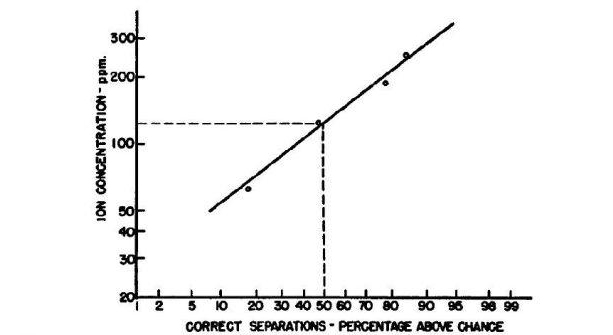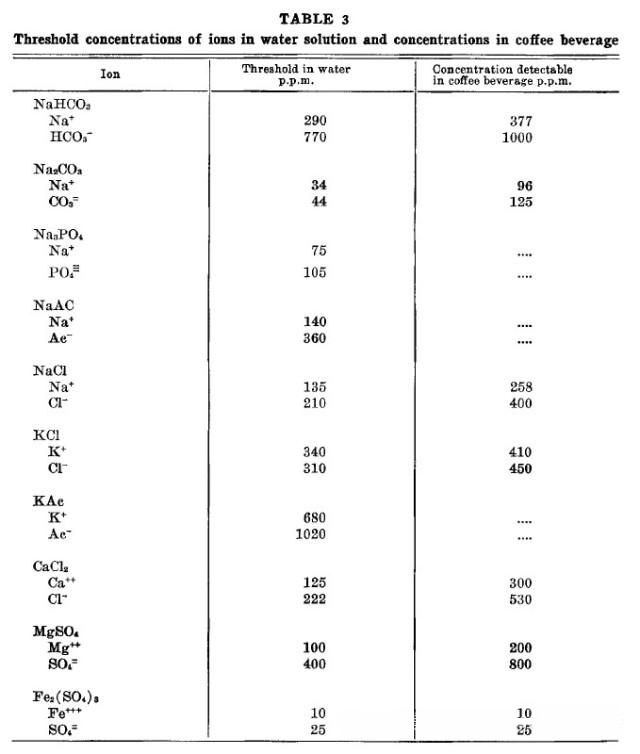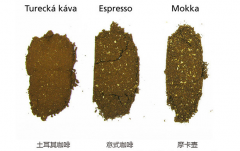SCAA Coffee extraction and TDS Water quality requirements Coffee extraction skills
Water with the same TDS (total amount of dissolved solids, English: Total dissolved solids) will not contain the same composition of soluble solids, so is it possible to be the same in flavor? The problem may come back to the minerals themselves. Because there are many metal cations and anions in the water, the common salty taste is mainly sodium ions. According to the periodic table, alkaline metal ions similar to it can pass through ion channels and produce salty ions, such as lithium or potassium ions. However, the higher the cycle, the less salty and slightly bitter.
The common salty substances are NaCl, KCl, NaI, NaNO3, KNO3 and so on. In addition, if the alkaline-earth divalent cations of calcium ions pass through the ion channels that produce salty taste, they produce not salty, but bitter taste, among which magnesium ion produces the strongest bitter taste. In addition, it will have a sweet taste if it contains borax and copper sulfate. Since there are so many kinds of ions in the water, it is possible to bring out sour, sweet, bitter and salty tastes, it is obvious that the water with different TDS contents must be different in taste, so it is quite complicated.
What is more curious is at what concentration of these ions will cause us to produce the above taste? So in 1955, Coffee Brewing Center did some research and investigation on the water quality of brewing coffee. Interesting experiments. They selected some common substances in the water and asked people to do cup tests on substances of different concentrations in a way similar to the current triangular cup test. Take calcium ion Ca2+ as an example: the researchers mixed different concentrations of Ca2+ aqueous solution with distilled water, which were 62, 125, 188 and 250 ppm, respectively. There are three cups of each concentration (the arrangement of these three cups may be that two cups contain this concentration of Ca2+ and the other is water, or two cups of water and one cup of Ca2+), and then invite at least 18 people to take part in the cup test, including men and women, smokers and non-smokers, all members are professional food tasters, and use their correct answers to identify the differences between the three cups as the minimum concentration that can be detected.

As shown in the table above, only 9 out of 20 people can be detected when the Ca ion concentration is 62 ppm, with a correct rate of 45%, while when the concentration reaches 250 ppm, the correct rate can reach 90%. Then, by presenting the correct data in the way of mapping, the regression curve can be calculated, and the minimum detectable concentration is defined as the minimum detectable concentration Threshold concentration of the substance with 50% accuracy.

Taken together, when calcium ion is less than 125 ppm, it is less than 50% likely to be drunk. What about the concentration of calcium ions that will be detected in coffee? The same method, brewing coffee with different concentrations of calcium ions, the method and detection principles are the same as above. Thus, the minimum detectable concentration in coffee can also be measured. As a result, the detected concentrations of a variety of different minerals in water and coffee are confirmed.

The above studies focus on the effects of a single substance on taste and coffee brewing, but what do you think if you add these substances together? A TDS of 150 may be a good consensus. But don't stick to this data. after all, the composition of water varies from place to place, and its special ingredients will also affect the extraction of coffee (recent scientific studies have shown that magnesium ions at high concentrations can increase the extraction rate and improve the flavor of coffee). Then the taste will be different.
Important Notice :
前街咖啡 FrontStreet Coffee has moved to new addredd:
FrontStreet Coffee Address: 315,Donghua East Road,GuangZhou
Tel:020 38364473
- Prev

How to make a good jar of milk foam in the teaching of Italian coffee mechanism?
How to make a good jar of milk foam? Before making a good bottle of milk foam, you must have a deep understanding of milk foam, and have a good teacher by hand, mouth and heart can be mastered in a short period of time, from shallow to deep to master the essentials of making milk foam, and then keep practicing to absorb the experience of making milk foam every time. First, Chongqing Bailesta Coffee West Point training Institute teaches espresso mechanism to make milk foam such as
- Next

The relationship between coffee grinding degree and extraction rate
There is already a lot of information about the grinding degree of coffee powder. Here, we will not explain how to choose the appropriate grinding degree for different appliances. This figure can show the relationship between different principles of appliances and grinding degrees. But you may have wondered why coffee needs grinding. Why is the grinding degree of different equipment matching coarse or fine? Do you want to rush?
Related
- Detailed explanation of Jadeite planting Land in Panamanian Jadeite Manor introduction to the grading system of Jadeite competitive bidding, Red bid, Green bid and Rose Summer
- Story of Coffee planting in Brenka region of Costa Rica Stonehenge Manor anaerobic heavy honey treatment of flavor mouth
- What's on the barrel of Blue Mountain Coffee beans?
- Can American coffee also pull flowers? How to use hot American style to pull out a good-looking pattern?
- Can you make a cold extract with coffee beans? What is the right proportion for cold-extracted coffee formula?
- Indonesian PWN Gold Mandrine Coffee Origin Features Flavor How to Chong? Mandolin coffee is American.
- A brief introduction to the flavor characteristics of Brazilian yellow bourbon coffee beans
- What is the effect of different water quality on the flavor of cold-extracted coffee? What kind of water is best for brewing coffee?
- Why do you think of Rose Summer whenever you mention Panamanian coffee?
- Introduction to the characteristics of authentic blue mountain coffee bean producing areas? What is the CIB Coffee Authority in Jamaica?

